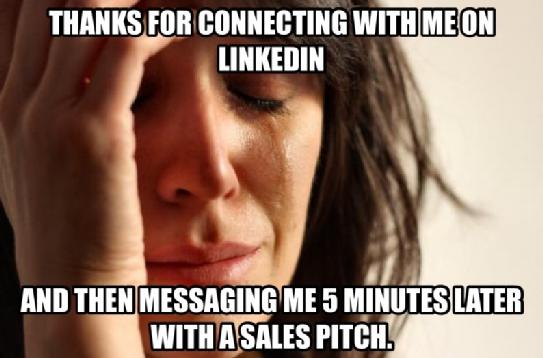4 Lessons From a Brilliant LinkedIn Sales Meme (And How to Apply Them)
LinkedIn for B2B Sales Reps
LinkedIn is one of the most powerful platforms available to B2B sales reps, and that’s why it’s frustrating to see so many reps using it incorrectly. “Using it incorrectly” is really an understatement. Several times a week B2B reps try to sell me something via InMail and fail miserably for the same reason. They request me as a friend and then, before 5 minutes goes by, they spam me with a form sales email. To make matters worse, they regularly use a fake title like “CEO” or “Director of Marketing” only to make it quickly and utterly clear that they are really just an SDR.
 The sad thing is that had they used LinkedIn properly, they could have gathered details about me that would have dramatically improved their chances of getting a response. From my LinkedIn profile they could have learned about my company, found any number of blog posts I’ve written, looked for mutual contacts and more. They could have used LinkedIn to craft the perfect, highly-targeted sales email. But instead, they almost immediately launched into the same tired pitch they had likely used on 50 other people that day.
The sad thing is that had they used LinkedIn properly, they could have gathered details about me that would have dramatically improved their chances of getting a response. From my LinkedIn profile they could have learned about my company, found any number of blog posts I’ve written, looked for mutual contacts and more. They could have used LinkedIn to craft the perfect, highly-targeted sales email. But instead, they almost immediately launched into the same tired pitch they had likely used on 50 other people that day.
LinkedIn Sales Pitches
I didn’t create this meme, but I sure agree with it. And I know I’m hardly the only one who new LinkedIn connections have immediately spammed. It’s a common problem that I’ve heard mentioned by co-workers, friends and colleagues. And the worst part is, that if LinkedIn becomes seen as just the predatory grounds for sales reps, it’s going to damage the social network. That’s a shame, since I know a lot of people (myself included) are using LinkedIn to make amazing industry contacts, collaborate on content and form communities with like-minded professionals.
LinkedIn for Lead Generation
There’s nothing wrong with using LinkedIn for lead generation or sales. But there are a lot of reps who need to vastly adjust their approach. Here are four tips for using LinkedIn for sales that can help B2B reps see better results (and be less annoying in the process):
- Never send a sales email the day you connect with someone on LinkedIn. That doesn’t mean you can’t reach out right away. I never mind getting a “thanks for connecting” email. And if it contains some personalized details (e.g. “I read your blog post on sales prospecting…”) it would only strengthen the bond.
- Don’t use LinkedIn for sending form sales emails. Ever. LinkedIn is a social network. If you want to sell to a prospect on LinkedIn at least take the time to add a personal touch. Show them that you know something about them and their company. Otherwise expect to be ignored/deleted.
- Don’t use fake job titles. If you’re an SDR, don’t say you’re a “Digital Marketer” just because you’re selling to digital marketers. It’s deceitful, and starts sales relationships off on terrible ground. There’s nothing wrong with being a salesperson. It’s a noble profession, so own it!
- Nurture contacts. Salespeople should act as miniature marketers. In marketing, we nurture leads so that they’ll be more sales-ready. B2B salespeople can do the same in LinkedIn. If you want me to find out about your company, start be sending me a relevant eBook that your company has created, share a blog post with me or invite me to a webinar. Start a conversation. Don’t just assume that prospects are going to be ready for a serious sales conversation just because they said “yes” to your friend request.
I would hate to see LinkedIn become irrelevant because of spam. That’s why it’s so important for salespeople and marketers to use it as it was intended – as a way to network, not as a garbage dump where bad sales pitches go to die.
